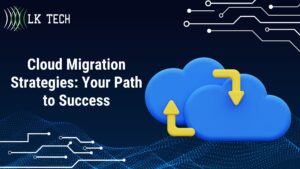The Cloud Migration Journey: Why, How, and What Makes Sense
Cloud migration has gone from a buzzword to a business necessity. With rising costs and economic uncertainty, companies must find ways to accelerate digital transformation and do more with less. Migrating to the cloud can provide a competitive edge, but only with careful planning tailored to your organization's unique needs. This article will explore why and how to migrate to the cloud, along with key considerations for different cloud models.

Cloud Migration Strategies: Your Path to Success
The Benefits of Cloud Migration
Cloud migration provides several overarching advantages that enable digital business. By moving IT resources off-premises to cloud platforms, companies gain flexibility, efficiency, and innovation. Specifically, the cloud:
- Alleviates the burden of managing on-site hardware/software - With cloud computing, businesses no longer need to purchase, install, and maintain their own servers and infrastructure. The cloud provider handles all of that. This frees up IT staff to focus on more strategic work rather than day-to-day maintenance.
- Frees up resources to focus on strategic initiatives - By reducing time spent on undifferentiated tasks like managing infrastructure, companies can better allocate resources to core competencies that drive competitive advantage. The cloud allows IT teams to become more agile and deliver greater business value.
- Provides on-demand scalability - Cloud platforms make it easy to scale computing power up or down based on real-time demand. This elasticity helps companies cost-effectively manage variable or unpredictable workloads.
- Allows geographic distribution - The cloud enables anytime, anywhere access to applications and data. This supports productivity across distributed teams and expansion into new global markets.
- Optimizes costs - The pay-as-you-go model reduces upfront capital expenditures. Businesses pay only for the resources they use. The cloud also enables easier automation to optimize usage and cut waste.
These benefits lead to improved business availability, shorter project timelines, enhanced security, and more. However, not all cloud models make sense for every application. Leaders must evaluate workloads to find the right cloud approach.
Choosing the Right Cloud Model
Successful cloud migration requires aligning initiatives with business goals and culture. Consider the following pathways:
Software as a Service (SaaS)
Best for non-differentiated applications like email, HR, finance, CRM, collaboration tools, and more. SaaS provides increased functionality, usability, and UI.
With SaaS, the cloud provider hosts, manages, and updates the software application. Users access the software via the internet, usually through a browser. This model provides a turnkey solution without the need to install, run, or update software locally.
SaaS enables easier collaboration across the organization and beyond. It also reduces demands on internal IT teams for application management and support. SaaS is a natural fit for common business software that does not deliver competitive differentiation.
Infrastructure as a Service (IaaS)
Enables on-demand access to fundamental computing, storage, and network resources on a pay-as-you-go basis. Well-suited for delivering business agility, scalability, and geographic reach.
With IaaS, companies can leverage advanced cloud infrastructure without investing in their own hardware. Resources are consumed as a utility without upfront costs. This supports dynamic business needs and workloads that ebb and flow.
IaaS empowers developers to quickly design, build, and iterate applications. It also enables legacy modernization by “lifting and shifting” workloads to the cloud. However, companies retain responsibility for managing applications, data, security, etc.
Private Cloud
Useful for traditional infrastructure modernization, especially in regulated industries. Maintain just enough private cloud to fulfill compliance needs while reducing complexity.
Private cloud provides a secure, controlled environment with the scalability benefits of cloud computing. This model gives companies more customization, isolation, and management of resources. It can support legacy workloads not yet ready for full public cloud migration.
The private cloud works well for applications involving sensitive data and regulated activities like healthcare, finance, government, etc. A hybrid approach combines the private cloud for targeted needs with the public cloud’s agility and innovation.
By selecting the right cloud approach per workload, companies can migrate applications smoothly while optimizing value.
Planning Your Cloud Migration
Migrating to the cloud requires careful planning focused on business impact. Follow these steps:
- Identify workloads suited for SaaS to improve non-core applications.
- Analyze current software systems and determine which delivers commoditized functionality with no strategic advantage. These are prime SaaS candidates.
- Look for opportunities to consolidate disparate tools/systems with integrated SaaS platforms. Reduce complexity and duplication.
- Align IaaS outcomes with key business goals like agility, innovation, and distribution.
- Determine where IaaS can accelerate application development, legacy modernization, and geographic growth.
- Build a business case for IaaS tied to tangible goals vs. technology for its own sake. Connect the dots.
- Maintain targeted private cloud to meet compliance, security, and latency needs.
- Pinpoint workloads requiring data residency, air-gapped security, and ultra-low latency.
- Right-size private cloud investment based on true needs vs. “just in case” overspending.
- Evaluate migration costs/benefits and adjust models accordingly.
- Develop total cost of ownership models comparing cloud vs. on-premises.
- Be ready to re-evaluate workloads as business needs evolve. Take an iterative approach.
- Provide adequate resources for complex implementation and change management.
- Assign cross-functional teams to manage end-to-end migration projects.
- Invest in training and communication to drive cloud adoption.
With the right cloud strategy tailored to your specific business priorities, you can unlock the full advantages of the cloud. Reach out to discuss your cloud migration goals and plan a successful journey.


